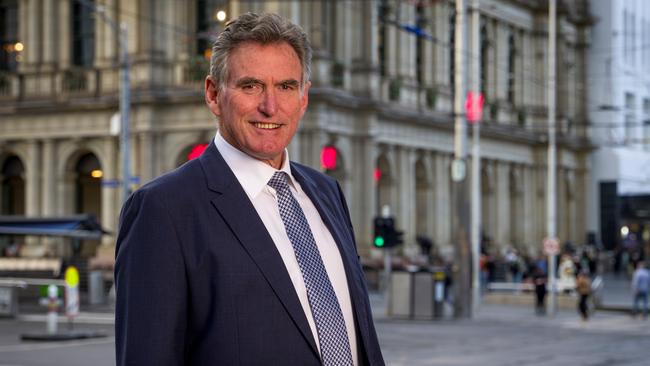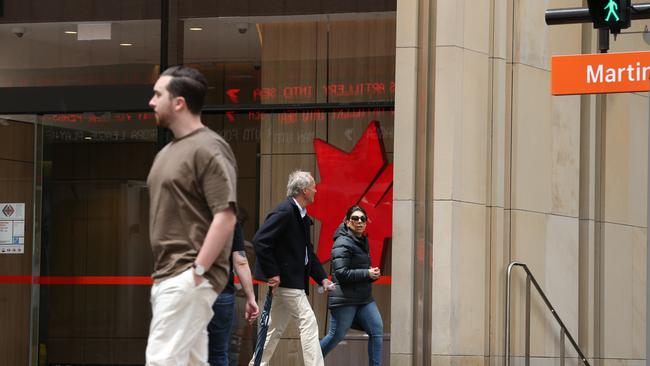NAB boss says Australia can defy rates hit, as profit hits $7.7bn
CEO Ross McEwan said inflation is too high, and the government needs a better long-term pathway on immigration, as he revealed annual profit of $7.7bn.

National Australia Bank says the Australian economy will defy the interest rates squeeze after posting a $7.73bn annual cash profit despite the drag of a spending slowdown tugging on the lender’s second half performance.
The headline result marks an 8.8 per cent lift in cash earnings for NAB, but was a miss on analyst expectations as margins for the Melbourne-based bank were crunched.
NAB’s full-year statutory profit also fell short of analyst expectations, coming in at $7.41bn, a 7.6 per cent improvement from the prior year’s $6.8bn. Analysts had tipped a $7.8bn statutory net profit for the period.
NAB chief executive Ross McEwan said Australia’s economy was capable of withstanding the pain after the 13th interest rate lift from the RBA since May 2022.
But Mr McEwan said both the bank and nation more broadly were “doing a bit of a balancing act” as interest rate rises crunched spending and lending, adding NAB was “playing the long game” and was expecting inflation to be tamed.
Speaking on Thursday morning, Mr McEwan said inflation was still too high, with the elevated cost of living “the biggest driver of stress” for NAB’s customers. But he noted the bank expected an economic rebound, likely to land in the second half of next year.
Mr McEwan also said “we need to settle down” concerns over immigration numbers, warning arguments against record arrival numbers ignored the massive loss of people during the Covid-19 pandemic.
But Mr McEwan said the record arrivals, set to hit 500,000 in September exceeding the 470,000 recorded by June, should not be repeated next year.
“We’re filling a gap that left,” he said, but he noted “we cannot keep absorbing 540,000 a year.”
Mr McEwan said access to labour was a “really important issue when I talk to business”, but noted the government needed to lay out a better vision for the long-term immigration pathway for Australia.
“We’re just not building enough houses, we’ve got to make it easier,” he said.
Mr McEwan said NAB was a big supporter of building more housing, but said governments must do more to make it easier to build.
Recent years have seen NAB pivot the bank from a heavily business lending focused operation to snap up an increasing share of the business deposit and home lending market.
But NAB has sat out of the mortgage wars that marked recent months, as Australia’s lenders competed to pick up borrowers rolling off cheap fixed rate loans signed during the pandemic.
The bank reported its loan book grew at 0.7 times the overall system growth, down from the 1.1 times posted by NAB in the prior period.
Mr McEwan said the hot competition was leading to “some of the thinnest mortgage margins I’ve seen in Australian banking” and was likely to continue for the next six to 12 months.
He said NAB was closely watching some of its borrowers, with concerns around new buyers who bought in the last two to three years.

Despite its moves to avoid price wars NAB has not been immune from the competition in the market, with Mr McEwan noting the period resulted in the banks earnings softening.
The bank’s net interest margin lifted by 9 basis points through the year to average 1.74 per cent, but this sagged in the second half, falling to 1.71 per cent, supported by the performance of the business bank.
The result was worse in the bank’s home lending which declined from 2.08 per cent in March to 1.87 per cent in September.
Personal banking slumped 9.1 per cent to $1.46bn as revenues tumbled.
Meanwhile, the bank’s divisional results showed a mixed picture across its earnings, with the business and corporate and institutional arms charging ahead, while personal banking retracted.
The business and private banking business arm reported a 10.1 per cent lift in cash earnings to $3.3bn.
Corporate and institutional earnings lifted by 14.9 per cent to $1.87bn as NAB benefited from higher margins offsetting lower lending volumes and higher expenses.
The New Zealand bank business also grew by 8.5 per cent to $1.5bn.
Mr McEwan said Australia’s economy would continue to grow in the coming year, but would face headwinds from weakness in household consumption driven by higher interest rates and rising costs of living.
“With inflation now moderating, the cash rate appears to be at or near peak levels and it seems likely that Australia will avoid a pronounced economic downturn,” he said.
Mr McEwan said the bank was seeing many of its customers actively budgeting for the first time in response to the rate rises warning although some had cut spending many were getting to a “to a point where they can’t flex it more”.
“People are serious about controlling their spend,” he said.
Mr McEwan said NAB was taking “prudent balance sheet” positions to prepare for potential loan losses, with collective provisions maintained above pre-Covid-19 levels.
NAB’s total capital funding lifted 71 bps in the period as organic capital growth combined with new frameworks from the prudential regulator, offset by $900m in share buybacks under the bank’s $1.5bn scheme.
The bank will hand investors a 84c final dividend — the highest since 2019 — bringing total returns for the year to 167c per share.
NAB handed shareholders 151c in dividends in the prior.
The cash payout ratio sagged to 67.7 per cent, down from 68.4 per cent posted by the bank in the prior year.
Jarden analysts Carlos Cacho and Jeff Cai said NAB’s earnings were a “broadly in line result across most metrics”, noting the bank had delivered a “very vanilla” set of accounts.
But Jarden noted NAB had performed better than Westpac on preserving its margins.
“We see some modest downside to consensus earnings from higher FY24E costs,” they said.
Citi analyst Brendan Sproules said NAB’s outlook had “little joy” for investors, with “little good news for the share price”.
NAB shares fell 0.8 per cent of 23c to $28.94.







To join the conversation, please log in. Don't have an account? Register
Join the conversation, you are commenting as Logout